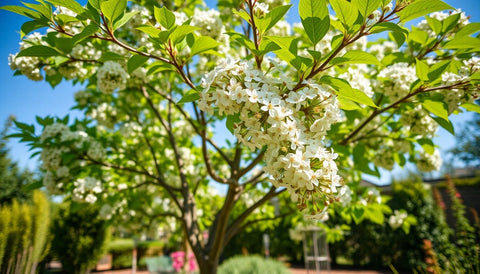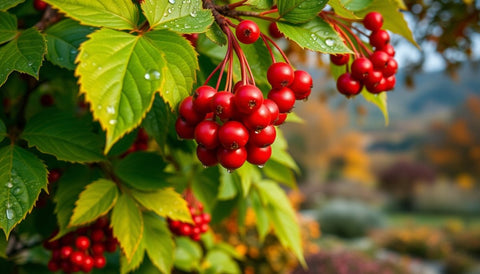Introduction
Serviceberry trees (Amelanchier species) are a beautiful addition to any garden. Known for their early fall blooms, these trees offer a delightful aesthetic and numerous benefits for wildlife and landscaping. In this guide, we’ll explore why planting Serviceberry trees can enhance your garden’s seasonal interest and provide year-round beauty and support for local ecosystems.

Understanding Serviceberry Trees
1.1 Overview of Serviceberry Varieties
There are several varieties of Serviceberry trees, including Allegheny, Downy, and Saskatoon. Each variety offers its own unique beauty and growth habits, making them suitable for different climates and landscapes.
1.2 Unique Characteristics
Serviceberry trees are known for their striking blooming cycle, producing beautiful white flowers in the spring followed by colorful foliage and delicious, edible fruits. Their leaves turn stunning shades of yellow, red, and orange in the fall, adding to their seasonal charm.
1.3 Growing Zones and Ideal Conditions
Serviceberry trees thrive in USDA hardiness zones 4 to 9, depending on the variety. They prefer well-drained soil and full sun to partial shade for optimal growth.
Benefits of Planting Serviceberry Trees
2.1 Environmental Benefits
Serviceberry trees support local ecosystems by attracting pollinators such as bees and butterflies. They also provide a food source for birds, especially with their delicious fruits in the summer.

2.2 Aesthetic Appeal
These trees are a beautiful choice for any garden. Their spring blossoms, vibrant fall foliage, and appealing winter silhouette make them a year-round asset to landscaping projects.
2.3 Edible Fruits
Serviceberries produce small, blueberry-like fruits that are delicious and versatile in cooking. They can be eaten fresh or used in pies, jams, and smoothies, making them a favorite among gardeners and wildlife alike.
How to Plant Serviceberry Trees
3.1 Choosing the Right Location
Pick a spot with full sun or partial shade. Ensure the soil is well-drained and fertile to help your tree thrive.
3.2 When to Plant
Serviceberry trees can be planted in both spring and fall, but early fall is ideal as it gives the tree time to establish roots before winter.
3.3 Step-by-Step Planting Guide
- Prepare the site: Clear the area of weeds and debris.
- Dig the hole: Dig a hole twice as wide as the root ball but no deeper.
- Plant the tree: Position the tree in the hole, ensuring the top of the root ball is level with the surrounding soil.
- Water and mulch: Water the tree thoroughly and add mulch to retain moisture and suppress weeds.
Care and Maintenance
4.1 Watering and Fertilization
Water young trees regularly to keep the soil moist but not waterlogged. Once established, Serviceberry trees are relatively drought-tolerant. Fertilize in early spring with a balanced fertilizer to encourage healthy growth.
4.2 Pruning Techniques
Prune in late winter or early spring to remove dead or damaged branches and to shape the tree for a balanced look.
4.3 Pest and Disease Management
Serviceberry trees are generally low-maintenance but can occasionally face issues like aphids or leaf spot. Regular monitoring and proper watering will help prevent major problems.
Enjoying Early Fall Blooms
5.1 Anticipating Fall Colors
Expect vibrant fall foliage, with leaves turning shades of red, orange, and yellow. This transition typically occurs in late September to early October, depending on your location.
5.2 Uses of Serviceberry Blooms in Landscaping
Serviceberry trees can be used as focal points in gardens or as part of a mixed border. Their blooms bring early color to the landscape, providing interest before many other plants have flowered.
5.3 Harvesting Fruits
Harvest the sweet, blueberry-like fruits in mid-summer. They can be eaten fresh or used in pies, jams, and other dishes.

Conclusion
Planting Serviceberry trees is a rewarding choice for any garden. With their year-round interest, from spring blooms to fall colors, these trees are a must-have for gardeners looking to enhance their landscape. Consider adding one to your yard for a beautiful and environmentally friendly addition.
Call to Action
Ready to plant a Serviceberry tree in your yard? Check out our Serviceberry trees available for purchase. Join local gardening communities or online forums to learn more, and don’t forget to share your experiences and photos with us!































Comments (0)
There are no comments for this article. Be the first one to leave a message!